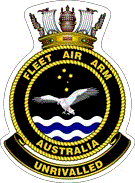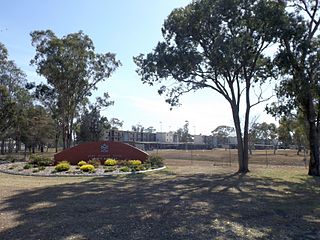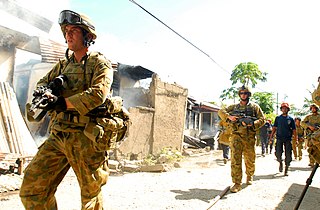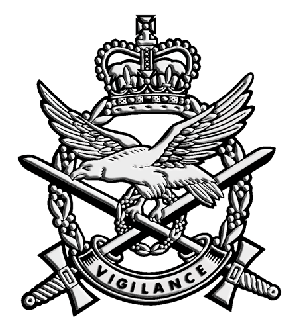
The Australian Defence Force (ADF) is the military organisation responsible for the defence of the Commonwealth of Australia and its national interests. It has three branches: the Royal Australian Navy (RAN), Australian Army and the Royal Australian Air Force (RAAF). The ADF has a strength of just over 89,000 personnel and is supported by the Department of Defence and several other civilian agencies.

The Australian contribution to the war in Afghanistan has been known as Operation Slipper (2001–2014) and Operation Highroad (2015–2021).

The NHIndustries NH90 is a European medium-sized, twin-engine, multirole military helicopter. It was the first production helicopter to feature entirely fly-by-wire flight controls.

This article describes the current structure of the Australian Army. It includes the army's order of battle and the headquarters locations of major units. Members of the Australian Army also serve within joint units of the Australian Defence Force which fall outside the direct command of the Australian Army.

The Fleet Air Arm (FAA), known formerly as the Australian Navy Aviation Group, is the division of the Royal Australian Navy (RAN) responsible for the operation of aircraft. The FAA was founded in 1947 following the purchase of two aircraft carriers from the Royal Navy. FAA personnel fought in the Korean War and the Vietnam War, and participated in later conflicts and operations from host warships.

The 1st Aviation Regiment is one of the Australian Army's three Army Aviation regiments and provides aerial reconnaissance and fire support to the Australian Army. The 1st Aviation Regiment, equipped with Eurocopter Tiger attack helicopters, forms part of the 16th Aviation Brigade and is based at Gaza Lines, Robertson Barracks, Darwin.

Oakey Army Aviation Centre is situated approximately 3 km (1.9 mi) from the town centre of Oakey in Queensland, Australia. It provides a training establishment for Australian Army Aviation, and also hosts the Republic of Singapore Air Force's "Cougar" 126 Squadron. The Defence name for the facility is Swartz Barracks, named for prominent politician, Army Aviation advocate, and ex-POW Sir Reginald Swartz.

Operation Astute was an Australian-led military deployment to East Timor to quell unrest and return stability in the 2006 East Timor crisis. It was headed by Brigadier Bill Sowry, and commenced on 25 May 2006 under the command of Brigadier Michael Slater. The operation was established at the request of East Timor's government, and continued under an understanding reached between Australia, East Timor, and the United Nations, with the United Nations Integrated Mission in East Timor supporting and helping to develop East Timor's police force. Other countries deploying soldiers to East Timor include Malaysia, New Zealand and East Timor's former colonial power Portugal, operating under independent command.
Tactical Transport Group was a Royal Australian Air Force (RAAF) group. It was established on 1 June 1988 as part of a broad-ranging reform of the RAAF's organisation.

The 171st Special Operations Aviation Squadron is an Australian Army helicopter squadron that provides aviation support to the Special Operations Command. The squadron is being equipped with the UH-60M Black Hawk helicopter. The squadron is based at Luscombe Airfield, Holsworthy Barracks, Sydney and forms part of the 6th Aviation Regiment as the regiment's sole operational squadron.

The Australian Army Aviation (AAAvn) is an administrative corps of the Australian Army. It was formed on 1 July 1968. The motto of the Australian Army Aviation corps is Vigilance.
The 173rd Special Operations Aviation Squadron is an Australian Army helicopter training squadron that provides support to the Special Operations Command. The squadron is being equipped with UH-60M Black Hawk helicopters. The squadron is based at Luscombe Airfield, Holsworthy Barracks, Sydney and forms part of the 6th Aviation Regiment.

The 6th Aviation Regiment is one of the Australian Army's three Army Aviation regiments and was raised on 1 March 2008 to provide air mobility for the Australian Army Special Operations Command (SOCOMD).
The 16th Aviation Brigade commands all the Australian Army aviation units and has technical control of the Army Aviation Training Centre reporting to Army Aviation Command. The Brigade was formed on 2 April 2002 by combining Headquarters Divisional Aviation and Headquarters Aviation Support Group and is headquartered in Enoggera Barracks, Queensland. It was originally named Headquarters 16th Brigade (Aviation) and was renamed to the 16th Aviation Brigade.

Operation Queensland Flood Assist was a complex, multi-Service activity by the Australian Defence Force (ADF) as a contribution to the response to the 2010–2011 Queensland floods. Coordinated to aid civilian emergency response efforts, at Federal inter-departmental level it was managed by Emergency Management Australia. It comprised units and personnel from the Royal Australian Navy (RAN), Australian Army, and Royal Australian Air Force (RAAF) operating as Joint Task Force 637. The operation was initially commanded by Colonel Luke Foster, based at Enoggera Barracks in Brisbane. When the ADF commitment was increased, command was transferred to Brigadier Paul McLachlan, Commander of the 7th Brigade, also based in Brisbane.
Operation Yasi Assist was a multi-Service activity by the Australian Defence Force (ADF) as part of the response to Severe Tropical Cyclone Yasi. Coordinated to aid civilian emergency response efforts, at Federal inter-departmental level it was managed by Emergency Management Queensland. It comprised units and personnel from the Royal Australian Navy (RAN), Australian Army, and Royal Australian Air Force (RAAF) operating as Joint Task Force 664. The operation was initially commanded by Brigadier Stuart Smith, based at Lavarack Barracks in Townsville.

The Australian Defence Force has operated Boeing CH-47 Chinook heavy-lift helicopters for most of the period since 1974. Thirty four of the type have entered Australian service, comprising twelve CH-47C variants, eight CH-47Ds and fourteen CH-47Fs. The helicopters have been operated by both the Royal Australian Air Force (RAAF) and Australian Army.

The MRH-90 Taipan was a version of the NHI Industries NH90 multirole helicopter in service with the Australian Army and the Royal Australian Navy in the early 21st century. It was withdrawn from service in 2022 by the Navy and in 2023 by the Army. Most of the aircraft were assembled in Australia. The fleet was originally scheduled for retirement in 2037. After the aircraft's withdrawal, they were offered for sale then disassembled for parts which is ongoing as of 2024.
















